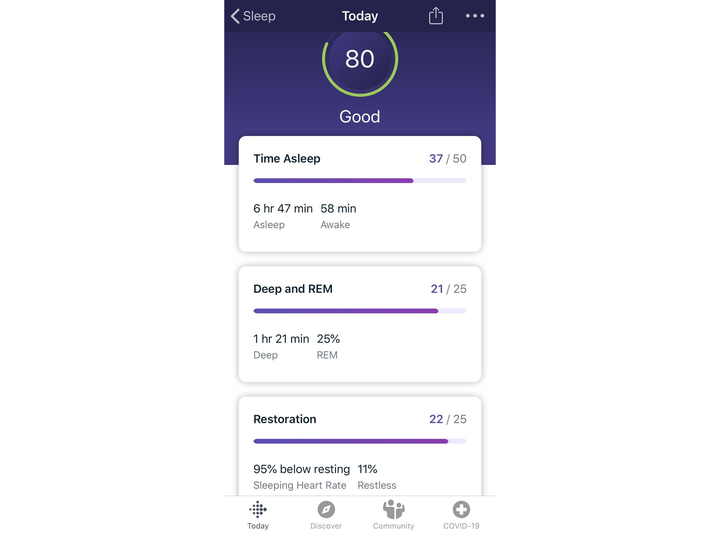New perk! Get after it with local recommendations just for you. Discover nearby events, routes out your door, and hidden gems when you sign up for the Local Running Drop.
Fitbit Charge 4, Rei.com
Price: $150
Basics: A super sleek, lightweight swimproof watch with built-in GPS and heart-rate monitor
Pros: An insane amount of functions and features for a health and fitness tracker at this price point
Cons: Small watch face makes it hard to see stats at a glance while running
They say good things come in small packages—and the new Fitbit Charge 4 is definitely living up to that cliche. Released earlier this week, it’s pitched as “the most advanced health and fitness tracker,” boasting built-in GPS, heart-rate monitoring, sleep tools, Fitbit Pay, and so much more, well, it’s taken until now to truly get into everything. There are so many functions and features that it feels like there’s no part of your life the Charge 4 won’t be able to help you with: swim, bike, run, hike, walk, sleep, Spotify, food tracking, sleep scores, mindfulness breaks, even COVID-19 hand washing reminders. Perhaps most importantly for us triathletes, the Charge 4 presents a relatively affordable way to get into heart-rate training as well as Strava, which, up until now, you’ve always needed to either carry a phone or have a more expensive GPS watch in order to access. Also, important disclaimer: due to current restrictions, this watch has not yet been tested in swim mode or treadmill mode, but we’ll get to those as soon as we’re able.
Fitbit Charge 4: The What
The Fitbit Charge 4 is the latest device from health and fitness tracking giant Fitbit, which was released April 13 and has its most advanced combination of sensors and features yet. With built-in GPS, heart-rate monitoring and a myriad of other “smart” features, it packs a huge bang for your buck when you consider its $150 price tag. Factor in its super sleek design and swimproof capabilities and you’ve got a sweet package. That said, remember that it’s definitely more of a “lifestyle” watch than it is a tri-specific unit, so if you’re looking for power data, interval functions, highly accurate GPS and so on, then it’s likely not the watch for you. It certainly feels like it’s aimed more at those newer to the exercise space than those who are advanced athletes.

Fitbit Charge 4: The Why and How
Fresh out of the box the Fitbit Charge 4 is easy to charge, set up, and get going. The small screen can be both a blessing and a curse—it’s simple and intuitive to use, but not always the easiest to see, especially when you’re on the move with it.
Much of the set-up is done in the Fitbit app, where you can also sync with apps like Strava, Spotify, Training Peaks, and scores more. It’s incredibly easy to spend hours getting into the weeds here (there’s an option to set your stride length for maximum accuracy), so be mindful of this.
There are GPS-enabled exercise modes for run, bike, swim, treadmill, walk, and outdoor workouts. You can set goals in each of these modes based on time, distance, or calories. Unlike some GPS watches, it picks up GPS relatively quickly. When we did a side-by-side test with the Polar M430, heart-rate on the Fitbit Charge 4 seemed to take a little longer to respond to sudden surges or efforts, but GPS was similar. We found it hard to see numbers while running, especially if you’re more accustomed to the bigger screens of Polars or Garmins, but obviously the data is all there for analysis afterwards.
There are some fun features on this watch that athletes of all abilities will enjoy: the sleep score function is super interesting, telling you how many minutes you’ve spent in light, deep or REM sleep each night, as is the relax function, which guides you through a personalized breathing session based on your heart-rate.
One of the key features of this watch is the Active Zone Minutes and, stemming from the WHO recommendation of getting 150 minutes per week of moderate exercise, it’s set up to measure and monitor this. Based on your age and resting heart rate, it measures time spent in one of three zones: fat burning, cardio, or peak. Many triathletes will obviously achieve this relatively quickly in their training week and it might seem like a somewhat redundant feature, but it still provides a handy post-workout analysis tool. It is likely more useful for someone just starting to establish an exercise routine.
Does It Work?
Yes! It’s simple and easy to use, helps you keep track of just about any piece of info you’ll ever want to monitor, and is a great way to stay motivated. The novice triathlete will gain more from it than the seasoned athlete, but even then there are still a host of other lifestyle features that make it worthwhile: sleep score, female health tracker, weight and body composition tracking (and it can be paired with a smart scale), food and water tracking, and so on.
What Else?
Fitbit is moving with the times and navigating our “new normal” with a COVID-19 specific tab in the app. There’s a huge amount of info here, including access to virtual doctors, hand washing reminders, at-home workouts, and real-time updates from the WHO.
It’s available in black, rosewood, or storm blue/black for $150, while the special edition retails for $170 and comes with a reflective black woven band as well as the standard black band. There’s a 90-day free trial of Fitbit Premium, which includes audio and video workouts, wellness reports, and mindfulness tools.
Fitbit Charge 4 Conclusions
For $150, the Fitbit Charge 4 represents one of the most affordable ways to access heart-rate monitoring and GPS-based training. If you’re relatively new to either of these forms of training then you’ll find this watch to be both helpful, motivating, informative, and a great gadget to help keep you on track. If you’re a more experienced athlete looking to analyze serious data then this isn’t the watch for that, but it’s the perfect tool to help you live an all-around healthy and balanced lifestyle.

